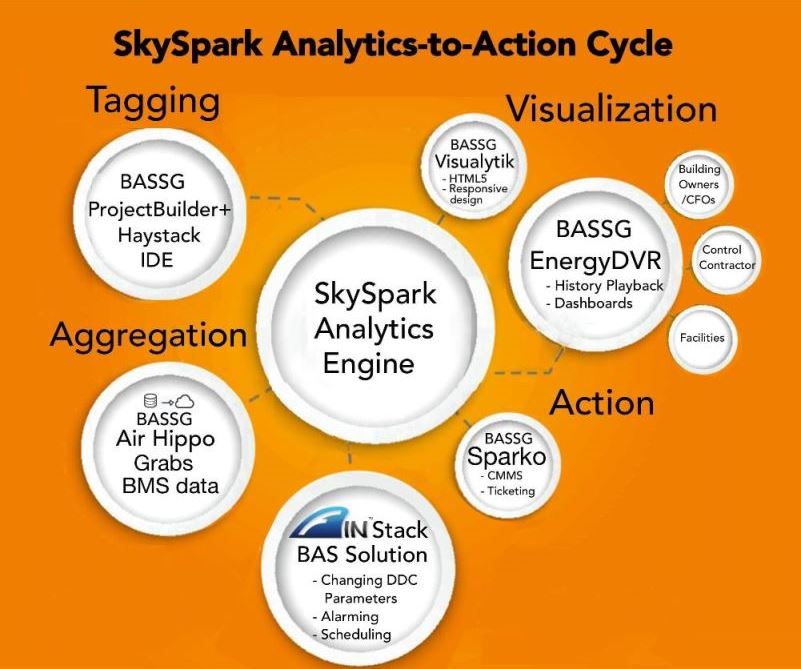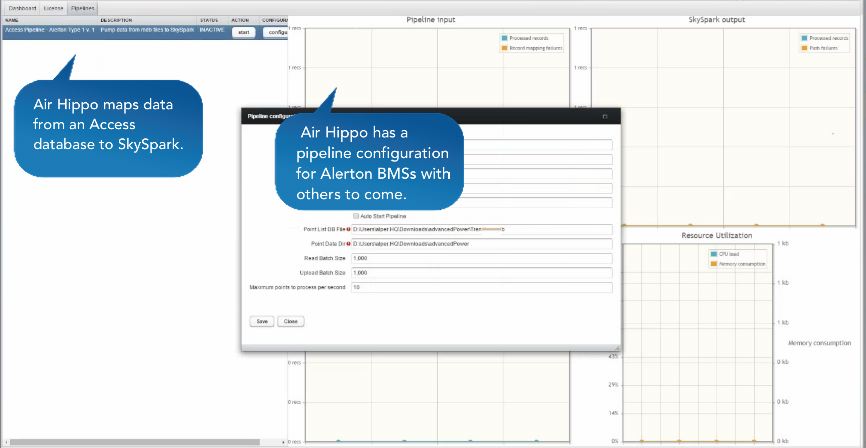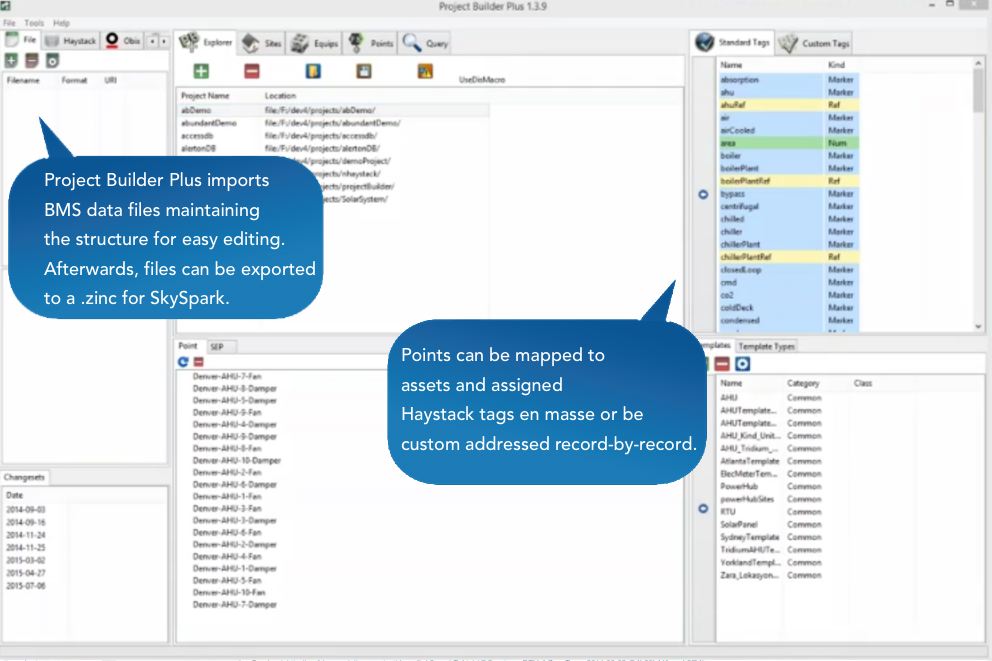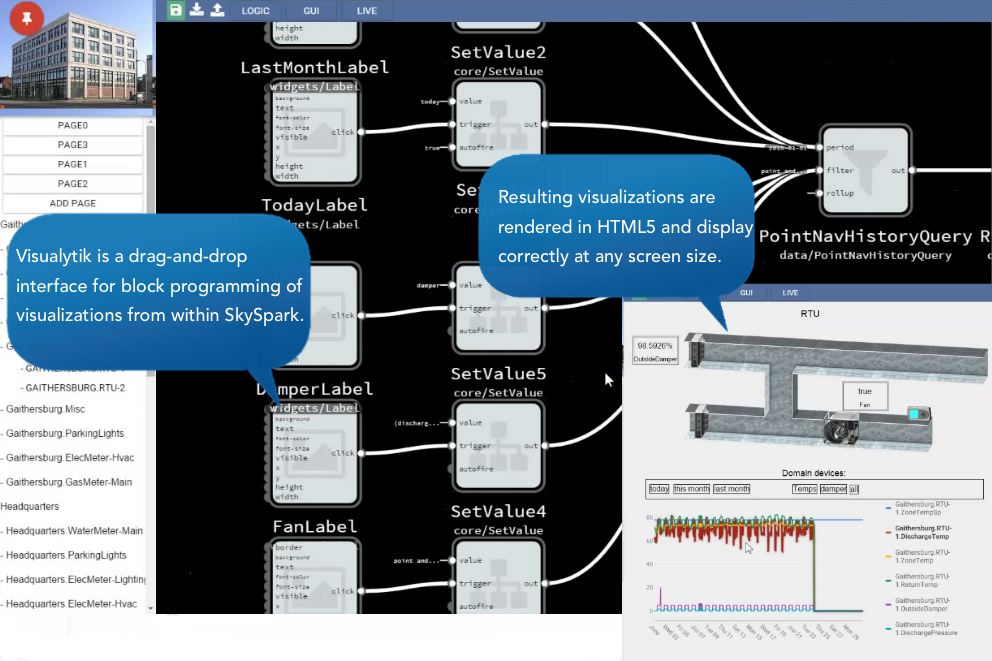
|
August 2015 |
[an error occurred while processing this directive] |
|
Vibrant Ecosystem Ups the Value of a Building's IoT Platform
How applications and services from partners like BASSG add to the
strength of the SkySpark™ platform, supporting data analytics project
teams through the whole cycle from data aggregation to action.
|
Therese Sullivan, BuildingContext Ltd Contributing Editor & Alper Uzmezler, BASSG Projects |
| Articles |
| Interviews |
| Releases |
| New Products |
| Reviews |
| [an error occurred while processing this directive] |
| Editorial |
| Events |
| Sponsors |
| Site Search |
| Newsletters |
| [an error occurred while processing this directive] |
| Archives |
| Past Issues |
| Home |
| Editors |
| eDucation |
| [an error occurred while processing this directive] |
| Training |
| Links |
| Software |
| Subscribe |
| [an error occurred while processing this directive] |
Those who have studied the dynamics of technology markets over the decades know that in times of rapid technology innovation and market growth, a company with a dominant product offering does well not to attempt to meet every customer need by itself. The better long-term strategy is to develop a strong partner network to fill out solutions. This approach offers better potential for delighting customers in all vertical markets and geographies. And many companies working together to grow a market are going to have better success than one company working alone. When it comes to the emerging Buildings Internet of Things (BIoT) market, the SkySpark™ Ecosystem is proving this theory once again. SkyFoundry’s network of Value Added Distributors (VADs) and Value Added Resellers (VARs) is going a long way towards making the SkySpark Analytics-to-Action Cycle a seamless, low-friction machine.

In the tech product marketing book, Crossing the Chasm, author Geoffrey Moore explains the concept of ‘whole product’ as all the complementary software applications, devices and services needed to fill out a core product to deliver compelling value to ‘Main Street’ customers. In this case, the ‘Main Street’ customers seeking a solution are all the building systems integration professionals and facilities teams that know a lot about their buildings but less about IT—particularly best practices in coding mobile and web apps and in managing large stores of digital data. To arrive at a building operational analytics platform that fulfills their whole product needs, system integrators can customize a solution that combines complementary offerings from within the SkySpark Ecosystem.
To better understand the various needs
that arise when using an analytics engine like SkySpark consider that
there are at least four major data challenges to face:
A key member of the SkySpark Ecosystem,
BASSG has solutions for each of these phases in the SkySpark
Analytics-to-Action Cycle. When you add these applications to the
SkySpark core, you get a very robust ‘whole product’ platform for
building operational analytics and the Building Internet of Things.
Moreover, you can further customize and build out your application
stack with complementary apps from other ecosystem partners, such as
those from the J2 Innovations FIN Stack suite. Today, there are
multiple pathways to SkySpark success. The following paragraphs
describe some of the challenges along the way and how partner apps
address them.
Air Hippo for Data Aggregation
BASSG’s Air Hippo grabs trend data from
an internal building automation system (BAS) archive and pushes it to a
remote SkySpark server. Today, the application can be installed on any
Alerton model BAS server. Support for other BAS systems are in the
pipeline. Without Air Hippo, an integrator would need to move data to a
Tridium JACE and then on to SkySpark. Air Hippo gets analytics
projects up and running faster and can help clinch IT approval for a
remote SkySpark deployment because it doesn’t require an open virtual
private network (VPN). Once installed on the BAS server, Air Hippo can
begin safely pushing data to SkySpark or other analytics servers as
long as ‘out data’ is permissable. In addition to Alerton trend
data, Air Hippo can source data from static .csv files and from SaaS
applications that have been specifically approved and setup for sending
to Air Hippo.

Project Builder Plus for Tagging
Project Haystack is an open-source
effort to standardize naming conventions and taxonomies for all the
smart devices, building equipment and energy systems targeting the
buildings industry. By working together toward easier and more
cost-effective information interchange, Haystack Community members hope
that the industry as a whole will be able to derive greater value from
buildings’ operational data. BASSG’s Project Builder Plus is
essentially an Integrated Development Environment (IDE) for Haystack
app development. While familiar to those well-versed in IT and
programming conventions, the concept of a desktop IDE is new to the
average building system integrator. The fact that integrators are
becoming app developers and need IDE’s is just one more way IT and
building automation worlds are converging. Use cases for Project
Builder Plus include:
Project Builder Plus can export files in .ZINC format—the most efficient file format for communicating with the HTTP protocol.

Visualytik - Graphical Way to Define SkySpark Visualizations
The SkySpark facility for creating visualizations is called
Folio. Folio has a layer called AXON that interrogates records to
create bar charts and line charts. Programming instructions for AXON is
a matter of writing line code. Visualytik is an HTML5 alternative to
AXON, making it easy for non-programmers to accomplish the same thing
using a drag-and- drop interface. SkySpark visualizations defined
in BASSG’s Visualytik will present correctly at different screen sizes.
In other words, Visualytik is a short-cut to creating responsive,
mobile-ready SkySpark interface designs.

EnergyDVR for Dashboard Visualizations
EnergyDVR is a graphical environment for building dashboards with 3D
graphics. It is unique in its ability to grab data from SkySpark within
the Tridum BMS interface. In effect, it straddles both the SkySpark and
Tridium trend logs and can play back a complete view of the portion of
the building environment of interest at any particular point in time.
Weekly, monthly, yearly roll-ups of trend data are easily presented.
The graphical interface is designed for visualizing per Floor Plan,
Plant, Air Handling Units (AHUs), Variable Air Volumes (VAVs) and more.

SparkO for Action Involving Manual Follow-Up
BASSG’s Sparko is a CMMS (Computerized Maintenance Management System)
for SkySpark. When issues and anomalies detected during analytical runs
warrant follow-up by maintenance staff, Sparko manages the ticketing.
In the SkySpark environment such calls for action are termed
‘Sparks.’ One of the largest drawbacks of early-generation
automated fault detection & diagnostics (FDD) programs was too many
false alarms; the algorithms were not tuned to what was actually
important. Sparko is designed to cut down on the extra noise of
ignorable ‘Sparks.’ When there is an issue like “AHU1 Damper
Stuck Open,” Sparko will create only 1 ticket, though there will be
many Sparks because a new one will be created at every interval.
All additional Sparks go into the ticket as appended ticket entries. If
there are no appended entries, Sparko can be instructed to not issue a
ticket for that Spark. Users of this CMMS are better able to track who
did what when. Another refinement Sparko offers is that you can map
specific SkySpark rules to members or departments of internal O&M
or to external team members like your automation contractor or MEP
engineer. Basically, it gives you the flexibiblity to get corrective
action in motion sooner.

bLine for Setting Up 2-Way Communication with Automation Programming
[an error occurred while processing this directive] In the SkySpark analytics-to-action cycle, Sparks can also trigger automated responses. For some commonly found and well understood faults - like wrong set points and scheduling errors - the platform can be extended beyond finding faults to automatically correcting them. The bLine block programming environment available within the FIN™ Stack BAS Solution from J2 Innovations eases Spark-to-DDC parameter-change programming. Users can move between block programming and line programming to compile instructions for the back-and-forth communication required to have Sparks trigger changes in control sequences, for example a DDC parameter change for not just a single AHU, but all AHUs of a tagged type everywhere.
Summary
Strategic use of the BASSG applications described above, as well as
those from other partners, can speed you along toward success with
SkySpark analytics projects. By addressing the typical challenges
encountered in the data aggregation, tagging, visualization and
follow-through, they can help you over the hurdles and lower the cost
of implementation. BASSG is an intelligent building solutions company
with more than 15 years of experience and more than 200+ clients and
full-time programmers on staff that know the languages and protocols of
the Buildings IoT. You can learn more at http://bassg.com/.
[an error occurred while processing this directive]
[Click Banner To Learn More]
[Home Page] [The Automator] [About] [Subscribe ] [Contact Us]